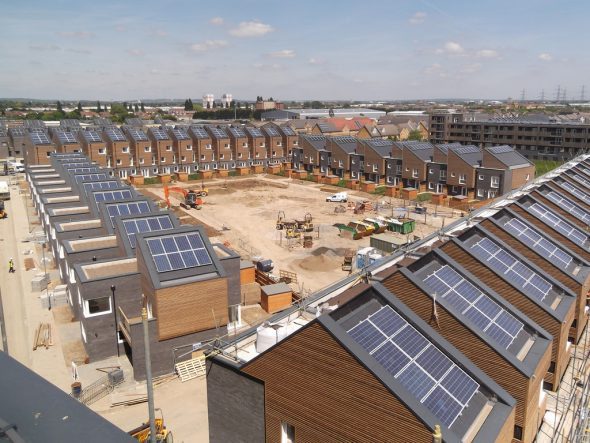As more than 200,000 solar households in Australia get ready to lose their premium feed-in-tariffs at the end of the year, most are wondering “what’s next” for their electricity arrangements. But the same question is being posed by big utilities, who are facing a scale and pace of disruption that could never have been anticipated.
Much has been written – on this website and elsewhere – about the impact of the (still) plunging cost of solar and the arrival of battery storage.

But the disruption and the opportunities being offered by those technologies is likely to be accelerated massively by the introduction of new software such as the “blockchain” system that has already taken root in financial systems.
This technology holds the promise of lower bills for consumers, more localised and community-based energy, greater resilience for the entire electricity system, and huge implications for incumbent business and regulators as they struggle to keep pace. And all this as regulators and market operators, as well as the fossil fuel lobby, look to old solutions to new problems, and continue to play down the benefits and promise of these new technologies.
These technologies will allow for smaller and smaller participants to transact energy in the retail and wholesale markets, through peer-to-peer rating and community-focused energy systems – such as micro-grids – and in some instances may by-pass some incumbents altogether.
Two of the closest observers of the transition of the energy utility business model have been Lawrence Orsini, the principal of US-based firm LO3, which has recently set up shop in Australia, and the team at Accenture Australia, led by Ann Burns and Simon Vardy.
The New York-based Orsini, who is in Australia to present at a major networks and utilities conference in Sydney this week, says the business models of utilities are being “shaken apart” by the changes in technology and the arrival of the “sharing” economy.
LO3 is involved in the Brooklyn micro-grid project in New York, part of their reshaping the power vision project, and in Germany. But he says the most interest has come from Australia, and several trials are expected to be announced in coming months.
The Australia interest, he says, comes as a result of the uptake of solar, the anticipated boom in battery storage, high energy costs, and the fact that the grid has not been built to be resilient.
That latter comment may come as a shock to those who justified the massive spending on infrastructure in recent years on meeting the 99.998 per cent reliability standard that is designed to allow just 11 minutes of outage per customer a year.
But the South Australia blackout proved a lie to that. And rather than being the fault of wind energy, as many pretended, the experience has underlined the fragility of Australia’s reliance on large centralised generators and huge networks that transport the energy hundred of even thousands of kilometres.
Just about everyone agrees that the way to provide a more secure, and low cost grid, is to focus on localised energy, featuring local power and sharing – a concept that Orsini describes as “transactive energy.”
The blockchain technology is important because it can off er a “cryptographically secure”, distributed ledger that can track where electricity was generated, where it can travel to and who used it.
“There is no question about where you got your kilowatt hour, where it came from and how it was produced,” he says. It is transparent and secure, and will make it easier for new and smaller players to be involved, right down to the individual solar household. In effect, another major step towards the democratisation of energy.
Orsini says his company is focused on the physical transaction of energy, not the financial transactions. They key, he says, is in the need for fast acting load responses, storage, controllable generation and reaction time.
“So what we need is a transitive grid,” Orsini tells RenewEconomy in an interview. “We are going to hit a tipping point where this is going to shift very fast.
“Any energy system that is running high on renewables, in combination with non renewables and storage, needs to move to market model that recognizes the value of a “negawatt” (the power you don’t use) as well as the value of megawatt. The grid architecture will change very quickly.”
Orsini says the Brooklyn project has already provided some valuable lessons, in particularly the interest from consumers in where the their electric came from.
“I was skeptical that people would have an interest in where energy coming from, but Brooklyn shook that up a bit. I didn’t understand how much of a driver was renewable energy, for solar on the rooftop, for community projects, and for their environmental benefits. In Brooklyn they want their electrons to be Brooklyn electrons.”
He says one of the biggest drivers in Australia will be location-based models for energy production, transportation and consumption.
“If you are buying your electricity from far away – and if you not paying for that cost, then it is socialised. You never see the real cost. As soon as you start paying for the real cost then the grid re-organises itself.
You will want to pay for stuff that is closer. We used to have no choice but to have a centralised, monopoly grid, but we didn’t need to do that any more.”
Orsini pointed to research by consultancy firm Accenture that suggested that 80 per cent of consumers wanted to “participate” in the market, not as active traders perhaps but certainly not as passive as they had been.
“I still don’t know that that computes with me,” Orsini admitted.
RenewEconomy recently interviewed Accenture energy experts Ann Burns and Simon Vardy, who are in no doubt that the shift in attitude of consumers – enabled by solar and storage – and the role that blockchain will play in that.
“The consumer will drive the agenda more and more,” says Burns. Sharing and community focused energy is “not something that can be prevented.”
Vardy says that blockchain has the capacity to “cut out the middle men” which may include retailers and generators, and the uptake will be driven by the changing consumer landscape and the emergence of the “millennial” as the largest consumer cohort – a position they will reach by 2020.










